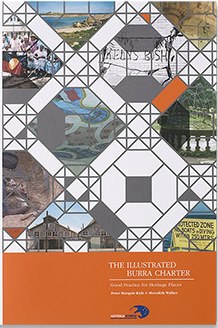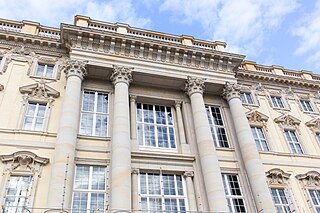Related Research Articles
The International Council on Monuments and Sites is a professional association that works for the conservation and protection of cultural heritage places around the world. Now headquartered in Charenton-le-Pont, France, ICOMOS was founded in 1965 in Warsaw as a result of the Venice Charter of 1964 and offers advice to UNESCO on World Heritage Sites.

Jūrmala is a state city in Latvia, about 25 kilometres west of Riga. Jūrmala is a resort town stretching 32 km and is sandwiched between the Gulf of Riga and the Lielupe River. It has a 33 km stretch of white-sand beach and is the fifth-largest city in Latvia.

Heritage interpretation refers to all the ways in which information is communicated to visitors to an educational, natural or recreational site, such as a museum, park or science centre. More specifically it is the communication of information about, or the explanation of, the nature, origin, and purpose of historical, natural, or cultural resources, objects, sites and phenomena using personal or non-personal methods. Some international authorities in museology prefer the term mediation for the same concept, following usage in other European languages.

Conservation and restoration of immovable cultural property describes the process through which the material, historical, and design integrity of any immovable cultural property are prolonged through carefully planned interventions. The individual engaged in this pursuit is known as an architectural conservator-restorer. Decisions of when and how to engage in an intervention are critical to the ultimate conservation-restoration of cultural heritage. Ultimately, the decision is value based: a combination of artistic, contextual, and informational values is normally considered. In some cases, a decision to not intervene may be the most appropriate choice.

Cultural heritage is the heritage of tangible and intangible heritage assets of a group or society that is inherited from past generations. Not all heritages of past generations are "heritage"; rather, heritage is a product of selection by society.
The Venice Charter for the Conservation and Restoration of Monuments and Sites is a set of guidelines, drawn up in 1964 by a group of conservation professionals in Venice, that provides an international framework for the conservation and restoration of historic buildings. However, the document is now seen by some as outdated, representing Modernist views opposed to reconstruction. Reconstruction is now cautiously accepted by UNESCO in exceptional circumstances if it seeks to reflect a pattern of use or cultural practice that sustains cultural value, and is based on complete documentation without reliance on conjecture. The change in attitude can be marked by the reconstruction in 2015 of the Sufi mausoleums at the Timbuktu World Heritage Site in Mali after their destruction in 2012.

The International Committee for the Conservation of the Industrial Heritage, usually known by its acronym TICCIH, is the international society dedicated to the study of industrial archaeology and the protection, promotion and interpretation of the industrial heritage. TICCIH's Nizhny Tagil Charter (archived), signed in 2003, is the international guidance document for the industrial heritage. In 2011, the Joint ICOMOS – TICCIH Principles for the Conservation of Industrial Heritage Sites, Structures, Areas and Landscapes, also called "The Dublin Principles", were adopted in Paris.

The Burra Charter is a document published by the Australian ICOMOS which defines the basic principles and procedures to be followed in the conservation of Australian heritage places. The Charter was first endorsed in 1979 as an Australian adaptation of the Venice Charter, but with the introduction of a new analytical conservation model of heritage assessment that recognised forms of cultural heritage beyond tangible and physical forms. The Charter was the first national heritage document to replace the Venice Charter as the basis of national heritage practice. The Charter has been revised on four occasions since 1979, and has been internationally influential in providing standard guidelines for heritage conservation practice.
Australia ICOMOS is a peak cultural heritage conservation body in Australia. It is a branch of the United Nations-sponsored International Council on Monuments and Sites (ICOMOS), a non-government professional organisation promoting expertise in the conservation of place-based cultural heritage. Its secretariat is based at the Cultural Heritage Centre for Asia and the Pacific at Deakin University.

Reconstruction in architectural conservation is the returning of a place to a known earlier state by the introduction of new materials. It is related to the architectural concepts of restoration and preservation, wherein the most extensive form of reconstruction is creating a replica of a destroyed building.
The Barcelona Charter, in full the European Charter for the Conservation and Restoration of Traditional Ships in Operation is an informal but widely accepted standard for maintenance and restoration projects on historic watercraft that are still in operation as active sailing vessels.

The International Centre for the Study of the Preservation and Restoration of Cultural Property (ICCROM) is an intergovernmental organization dedicated to the preservation of cultural heritage worldwide through training, information, research, cooperation and advocacy programmes. It aims to enhance the field of conservation-restoration and raise awareness to the importance and fragility of cultural heritage.
The Principles for the Conservation of Heritage Sites in China is a conservation charter promulgated in 2000 by China ICOMOS with the approval of National Cultural Heritage Administration. It provides a methodological approach to the conservation of cultural heritage sites in China.
The Nara Document on Authenticity is a document that addresses the need for a broader understanding of cultural diversity and cultural heritage in relation to conservation in order to evaluate the value and authenticity of cultural property more objectively. It was drafted by 45 representatives from 28 countries after their deliberation on the definition and assessment of authenticity during the Nara Conference held in Nara in November 1994.

The Foundation for the Humboldt Forum in the Berlin Palace is a German foundation established by the Government of Germany to create the Humboldt Forum museum in the reconstructed City Palace, Berlin. It works closely with the Federal Government Commissioner for Culture and Media. Following a resolution passed by the German Parliament, the Bundestag, it receives funding from the Federal Ministry of Transport, Building and Urban Development.
The following is a timeline of the history of the city of Riga, Latvia.

The Birthplace of Simón Bolívar is a seventeenth-century house in the Venezuelan capital city Caracas where the hero of Venezuelan and Latin American independence, Simón Bolívar, was born. Now a significant tourist attraction, the building is located in a little street off the Plaza San Jacinto, a block east of the Plaza Bolívar. It is one of only a few houses from the colonial era which survive in central Caracas.
Virtual archaeology is a term introduced in 1990 by archaeologist and computer scientist Paul Reilly to describe the use of computer based simulations of archaeological excavations. Since that time, scientific results related to virtual archaeology were annually discussed, among others, at Computer Applications and Quantitative Methods in Archaeology (CAA). The keyword "visualization" defined the aim of the virtual archaeology in the London Charter Initiative:
It should be made clear to users what a computer-based visualization seeks to represent, for example the existing state, an evidence-based restoration or an hypothetical reconstruction of a cultural heritage object or site, and the extent and nature of any factual uncertainty.
Digital heritage is the use of digital media in the service of understanding and preserving cultural or natural heritage.

The Commission to Preserve National Monuments of Bosnia and Herzegovina, abbr. KONS, is Bosnia and Herzegovina commission (agency) which declares and registers national heritage monuments/sites, including natural/urban/architectural assembles, immovable and movable heritage of historical and cultural importance to Bosnia and Herzegovina, as an institution at state level. The sites of exclusively natural heritage are not subject of Annex 8 and the KONS.
References
- 1 2 The Riga Charter on Authenticity and Historical Reconstruction in Relationship to Cultural Heritage archived on a German website, viewed 2011-04-18
- ↑ Dushkina, Natalia Reconstruction and its interpretation in Russia – 2 viewed 2011-04-18 on Icomos website
- ↑ Riga Charter on FEDECRAIL website, viewed 2011-04-18
International cultural heritage documents